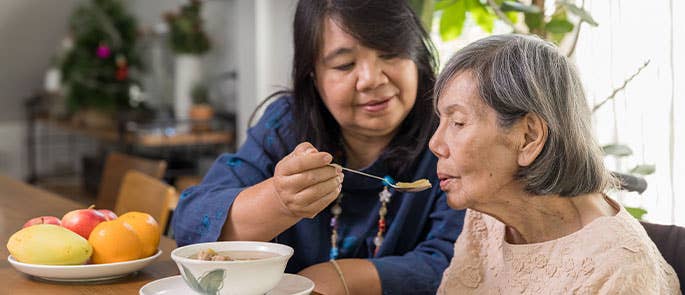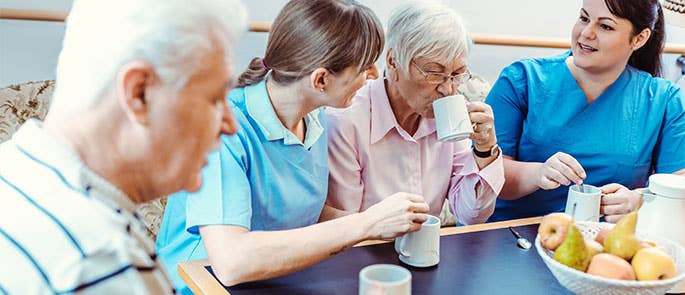Malnutrition in the Elderly
Malnutrition in the elderly is an important condition to be aware of if you work in the health and social care sector, as it can have a severe impact on an older person’s health, wellbeing and quality of life. Your duty of care towards those in later life extends to what they eat and drink on a daily basis, and understanding what malnutrition is and how to spot it is essential knowledge to have. In this article, we’ll look at what malnutrition in the elderly is, the common causes of malnutrition and how to prevent malnutrition from developing.
What is Malnutrition in the Elderly?
Malnutrition in the elderly is when a person isn’t eating well enough to maintain their general health and wellbeing. It’s generally caused by not eating enough or not eating the right nutrients, but it can also be caused by a variety of other physical, psychological and social issues.
Malnutrition is a common problem in the UK and anyone can be at risk, regardless of their age, gender or body type, but it’s more likely to occur amongst those aged 65 and over. Charity AgeUK estimates that around one in ten people over the age of 65 – over one million people – are currently malnourished or are at risk of malnutrition.
Losing weight should not be seen as an inevitable part of getting older. If an elderly person you know or care for is losing weight unintentionally, then it’s important that their diet is assessed to ensure they are getting enough food and the right nutrients each day.
If not addressed, malnutrition in the elderly can lead to a low body weight, drastic weight loss, a weak immune system and longer recovery times from injury or illness. It can also mean more visits to the doctor or hospital.
Looking to Learn More?
Care Certificate Standard 8 ‘Nutrition and Fluids’ requires all care workers to understand the importance of nutrition, hydration and eating well. They must also ensure that those they care for are following a suitable diet based on their care plan. This means having good knowledge of both malnutrition and dehydration, their causes and how to prevent them.
The Difference Between Malnourishment and Malnutrition
Malnutrition and malnourishment are very similar terms that both refer to a lack of nutrients in the body.
Malnutrition is a serious, diagnosable health condition that happens when a person’s diet does not contain the right amount of nutrients needed for good health. It can refer to both undernutrition, where a person isn’t consuming enough nutrients or overnutrition, where a person is consuming more nutrients than their body needs.
Malnourishment is the term used to describe a person’s general poor health as a result of them having too little food or too few nutrients in their diet. A person who is malnourished may not be eating properly or eating a diet consisting of mostly unhealthy, processed foods, meaning their body is weak and in poor health. Malnourishment is not a diagnosable condition but more of a descriptive word used to describe someone’s poor health.
Malnourishment does not necessarily lead to malnutrition, but is often a key contributing factor.
Causes of Malnutrition in Older Adults
Malnutrition in older adults can be caused by a variety of factors, including physical, psychological and social issues. Losing weight should never be seen as part of the ageing process as, with the right interventions, malnutrition can easily be prevented.

Some of the causes and risk factors for malnutrition in older adults include:
- Natural changes in perception of taste and flavour as a person gets older.
- Prescription medicines that suppress appetite.
- Poor oral health, dental problems or swallowing difficulties (dysphagia).
- Cognitive decline, including dementia and delirium, meaning meals are forgotten.
- Social isolation and loneliness, causing lack of interest in food.
- Grief and bereavement, which can reduce appetite.
- Resistance to care.
- Depression and other mental health issues.
- Financial worries about the cost of food.
- Limited mobility, making food shopping difficult.
- Difficulty preparing or cooking meals due to a physical impairment.
- Lack of energy to make meals.
- Long-term health conditions that suppress appetite or make eating difficult.
Signs and Symptoms of Malnutrition in the Elderly
The signs and symptoms of malnutrition in older people are often obvious to carers, family and friends as they usually affect a person’s physical appearance or are reflected in their behaviour. If you notice any of these signs and symptoms in someone you know or care for, then it’s important to encourage them to seek help and advice from their GP.
Examples of the physical symptoms of malnutrition in older people include:
- Unintentional weight loss (between 5-10% of their weight within 6 months).
- A low body weight and a BMI under 18.5.
- No interest in eating or drinking.
- No desire to plan meals, food shop or cook.
- A much smaller appetite than usual.
- Feeling tired and lethargic all the time.
- Feeling weak and low in energy.
- Frequent illness and taking a long time to get better.
- Noticeable difficulties chewing and swallowing food.
- Loose-fitting dentures.
If you are a carer or family member of someone in later life, it’s a good idea to keep an eye on their diet and weight and keep a record of anything that feels out of the ordinary to you. If you notice anything that concerns you and are worried someone may be malnourished, then speak to a healthcare professional for advice.
It’s also important to encourage the older person to see their own GP, as they will be able to measure the person’s height and weight, assess their circumstances and recommend treatment to help prevent malnutrition if required.

How to Prevent Malnutrition in the Elderly
The best way to prevent malnutrition in elderly people is to encourage them to eat a healthy, balanced diet and a variety of foods containing carbohydrates, protein, fat, vitamins and minerals.
The NHS suggests that, in the first instance, malnutrition should be addressed by making some dietary changes. This includes eating high-calorie, high-protein ‘fortified’ foods, introducing more snacks between meals and drinking fluids that contain lots of calories. For example:
- Switch to full-fat versions of milk, yoghurt and cheese.
- Include a form of protein in every meal.
- Add nuts, seeds and lentils to meals.
- Eat small, regular meals instead of three big ones.
- Have a biscuit or pastry as a snack between meals.
- Use full-fat milk in hot drinks.
- Stay hydrated with 6-8 drinks per day.
If these dietary changes are not enough to resolve the issues caused by malnutrition, particularly if the person has a reduced appetite, little interest in food or difficulty preparing meals, then try the following tips:
- Encourage meal planning so that meals are not missed or forgotten.
- Establish an eating routine with the older person. Creating a visual calendar with meal and snack times on it can be particularly beneficial for those with impaired memory.
- Suggest smaller portions of food, as these may be less overwhelming and easier for the older person to eat more regularly.
- For older people who have difficulty chewing or swallowing, offer softer or liquid foods that they can consume more easily, like mashed potato, soups and milkshakes.
- Organise a regular supermarket home delivery, a recipe box service or ‘meals on wheels’ delivery, so the older person doesn’t have to think about what they’re going to eat each day.
- Provide the older person with options – not all meals need to be made from scratch with lots of ingredients. Instead, show them the benefits of frozen foods, ready meals and tins as more convenient options.
- Encourage the older person to eat their meals with family or friends to reduce feelings of loneliness.
- If required, a home care visitor can be assigned to the older person to help them shop for food and prepare meals.
- A meeting with an occupational or speech therapist can help to identify barriers to eating well and put practical solutions in place.
Malnutrition in the elderly is a serious health condition that can affect a person’s physical health, mental wellbeing and overall quality of life if not addressed. As someone working in health and social care, you have a responsibility to encourage the older people you work with to eat a balanced, healthy diet that’s high in nutrients. Keeping an eye on the symptoms of malnutrition and taking steps to control them will help to prevent malnutrition in the elderly.
Further Resources:
- Care Certificate Course
- How to Combat Dehydration in Health and Social Care
- Urinary Tract Infections in the Elderly: A Guide for Healthcare Professionals
- How to Prevent Falls in the Elderly











